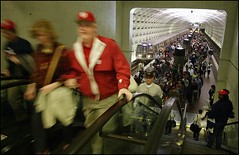Rigorous analysis and hard facts in the face of conventional wisdom
 People using the subway to go the home opener for the Washington Nationals. Photo from the Washington Post.
People using the subway to go the home opener for the Washington Nationals. Photo from the Washington Post.The Brookings Institution Metropolitan Policy Program writes about the Richard Shatten Prize in Cleveland. According to an article by Bruce Katz and Jeanne Shatten, reprinted on their website, but originally in the Cleveland Plain Dealer:
"The prize is a befitting testimonial to Richard, who played such a significant role in projects like the Playhouse Square renovation, development of Cleveland's Inner Harbor and a plethora of other neighborhood housing and development efforts. As director of Cleveland Tomorrow, Richard insisted that rigorous analysis and hard facts had a critical role to play in public policymaking, even when such analysis flew in the face of conventional wisdom.
Richard understood that the history of U.S. cities is one of relentless change and evolution. Neighborhoods change with the arrival of new immigrants and the aging of residents. Economies change with the introduction of new technologies and global relationships. Even popular images of "the city" change with the shifting of cultural attitudes and consumption preferences.
Like many cities in the Northeast and Midwest, the pace of demographic and economic change is forcing Cleveland to reassess its position in the economy and re-imagine its form and function. Across our country, broad forces are increasingly promoting diversity, density and urbanity. Demographic trends—population growth, immigration, migration, aging, smaller household size—are giving cities and urban places a better shot at attracting and retaining residents than at any time since the 1950s. Economic trends—globalization, technological innovation, deindustrialization—are also giving cities and urban places a renewed economic function and purpose.
An economy based on knowledge bestows new importance on universities and medical research centers, many of which, like Case, are located in the heart of central cities.
More generally, the shift to an economy based on ideas and innovation - where metropolitan areas compete fiercely for educated workers and entrepreneurs - changes the value and function of density and natural assets like rivers, lakes and parks.
The real question for Cleveland and the region, is whether a metropolis built for the industries and residential patterns of the 20th century can adapt to the very different climate of the 21st century. (...)
As Richard said to a Brookings Institution forum in 2000, "being right is irrelevant" to the growth of cities and metropolitan areas. Good ideas are critical, but they only have impact when they are implemented thoughtfully and effectively. And sound implementation only happens when a community develops a civic, corporate and political culture that can translate good ideas into action and execute with discipline and imagination. How a city and region creates, sustains and nurtures such a culture is the question for our time.
__________________
Compare "A Good Deal for the Nats" co-authored by Mayor Williams and Councilmember Jack Evans versus these two editorials about baseball from the Washington Times, "Baseball, TV and the Anti-trust exemption" and "Sponsoring RFK."



0 Comments:
Post a Comment
<< Home